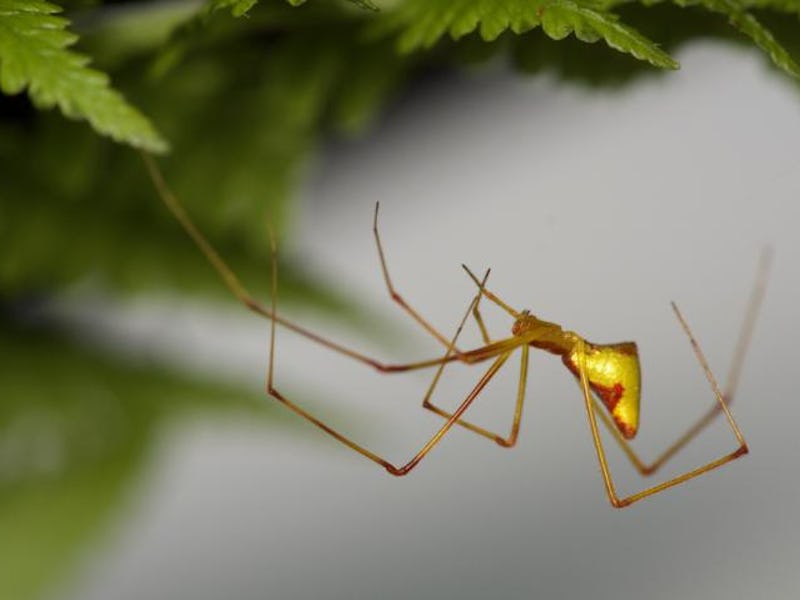The Same Spider Seemed to Evolve Over and Over Again in Hawaii
There are 14 different species, but they're all pretty much the same.

The Hawaiian islands are the world’s most isolated landmass, approximately 2,361 miles from the nearest continent. Cut off from the rest of the world, evolution in the lush archipelago turned inward, causing biodiversity to explode in a number of strange ways. On Thursday, scientists reported that a rare variation on the evolution process, unique to regions as isolated as Hawaii, had a very unusual effect on the Hawaiian Aramnes stick spider: it made the same spider evolve multiple times.
These spiders can be found in various habitats across the islands, with segmented bodies that come in brown, matte white, and glittering gold. Their colors and stomping grounds may differ, but that’s pretty much all that’s different — which is what makes the fact that so many of them have evolved independently of each other so fascinating. In the new study published in Current Biology, scientists explain how each of these spiders evolved independently of one another yet still managed to look the same.
“This very predictable repeated evolution of the same forms is fascinating because it sheds light on how evolution actually happens,” lead author and University of California, Berkeley biologist Rosemary Gillespie, Ph.D., said in a statement released Thursday. “Such outstanding predictability is rare and is only found in a few other organisms that similarly move around the vegetation.”
The mottled brown Molokai spider.
These spiders, which live in forests 2,000 feet above sea level on the islands of Kauai, Oahu, Molokai, Maui, and Hawaii, have undergone rapid and repeated evolution for thousands of years. Today, there are 14 species of Hawaiian Ariamnes stick spiders, and across the islands, they have evolved into the same distinctive forms, which are known as ecomorphs. For example, there is the brown spider that lives in rocks, the gold one that lives under leaves, and the white one that lives on lichen — but they’re all nocturnal anthropods that descended from the same spiders that came to Hawaii between two to three million years ago.
Ecomorphs are extremely rare, and the study’s scientists hope that by studying these spiders they’ll gain a better overall understanding of adaptive radiation. In evolutionary biology, adaptive radiation is when a lineage rapidly diversifies, each with evolved adaptations. The most famous example of this is Darwin’s finches, which evolved to have different beaks to suit their different environments.
Adaptive radiation led these spiders to diversify into exactly three ecomorphs each time a spider has jumped over to a new island and became a distinct species. This process creates new species that are more closely related to the ecomorphs on their island than their lookalikes on the other islands. So, when a brown spider hopped from an old island to a new one, it diversified into new species of brown, white, and gold spiders before any of the gold and white spiders from the first island made it over.
The white Maui spider.
Moving is key to the adaptive strategies of these spiders. They don’t spend their days in webs, so they’ve had to evolve into forms that are better for scurrying around rocks and not being eaten by Hawaiian honeycreepers. Because Hawaii is a chain of islands that formed chronologically, Gillespie and her team were able to see how these adaptations happened over time as they studied spiders living on the oldest island, Kauai, to the youngest island, the big island of Hawaii. Genetic samples revealed that spiders were closer relatives to the spiders of their own islands: a white spider on Oahu, for example, is a closer relative to a brown spider on Oahu than a white spider on Maui.
Ecological Forms of the Hawaiian Ariamnes.
Gillespie theorizes that there is never any additional diversification — there are no stick spiders in Hawaii that are orange or striped — because they may have a preprogrammed switch in their DNA that allows them to evolve rapidly into these successful forms. The adage “if it’s not broke, don’t fix it” applies itself well to this situation, even if the scientists aren’t quite sure how the process works. Continued studies of these spiders ideally will illuminate the mysteries of adaptive radiation works and teach the scientists how evolving in isolation may have made the spiders more vulnerable to environmental changes and invasive species.
“We need to be able to figure out this diversity and document it and describe what’s so special about it, so that people know about it,” says Gillespie. “It’s being lost and it’s a desperate situation.”